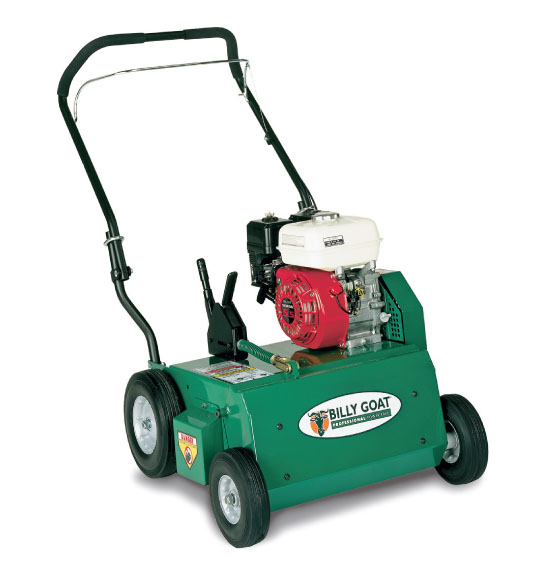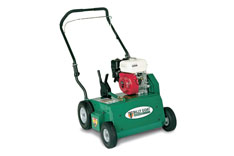Click and drag image to rotate.
Power Rake (Dethatcher)
Power Rake (Dethatcher)
Model #:
- PR550 (Briggs) / PR550H (Honda)
Features
- Heavy-duty infinite height adjustment
- Steel guards to protect bearings & pulleys
- Heavy-duty wheels
- No-tool folding handles
- Converts to overseeder or vertislicer with optional accessories
Specifications
- Engine: 205 cc Vanguard (PR550); 162 cc Honda (PR550H)
- Depth: Infinite
- Depth Adjustment: .125” with up to .5” adj. for blade wear
- Reel: 20” Flail
- Productivity: 13,000 sq. ft/hr
The PR550 efficiently removes matted thatch from turf in 20” passes, and its rugged design withstands the most demanding use.
Because the rotation is down sweep, the flails propel the PR forward, making it self-propelled and reducing fatigue.
Additionally, because it weighs slightly more than other power rakes on the market, with steel guards, heavier wheels, premium bearings, and a 10-gauge steel engine base, the PR absorbs much of the vibration before it is transferred to the handle, which improves operator comfort and handling.
The PR comes standard with Honda or Briggs power coupled to a free swinging , heat treated, tempered flail blade reel, mounted to heavy-duty cast iron pillow block bearings with grease zerks. The PR is convertible to overseeder or vertislicer with optional accessories.
-
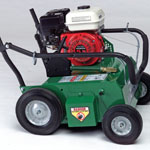
PR550 No Thread, No Bolt Foldable Handles
Great for storage, transport and long life.
-
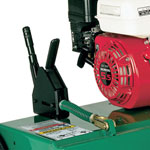
PR550 Infinite Heavy-Duty Depth Adjustment
Save on blade wear when compared to preset adjustments that may promote premature flail wear.
-
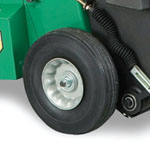
Heavy-Duty Wheels
Steel rim and roller bearings stand up to the most demanding customers and applications.
-
_150x150.jpg)
Premium Steel Pulleys, Easy to Adjust Idler & Easy to Change Belt
Contribute to simple service and long life. Protected by a steel guard.
-

Cast Iron Pillow Block Bearings with Grease Zerks
Provide longer life vs. plastic
-
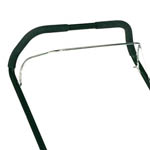
Premium Inside Mounted Engagement Bale
Premium Inside Mounted Engagement Bale
-
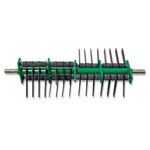
PR Flail Reel
Standard on PR. Heat treated and tempered blades stand up to heavy use. PN 350112.
-

PR Warranty
3-year engine
| Engine: | 205 cc Vanguard (PR550); 162 cc Honda (PR550H) |
| Depth: | Infinite |
| Depth Adjustment: | .125” with up to .5” adj. for blade wear |
| Reel: | 20" Flail |
| Productivity: | 13,000 sq. ft/hr |
| Weight: | 160 lbs. |
| Length: | 45.5" |
| Width: | 26.5" |
-
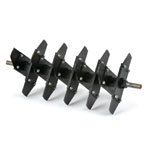
Vertislicing Reel
Part #: 350113
Perfect for thinning running grasses, improving drainage and overseeding.
-
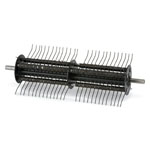
Optional Spring Tine Reel
Part #: 350355-S
Efficiently removes thatch with a softer touch where sprinkler heads or other objects may be a concern.
-
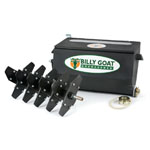
Overseeder Conversion Kit
Part #: 350328
Everything you need to convert your PR Power Rake to an overseeder. Kit includes Seed Box (Part No. 350325) and Vertislicing Reel (Part No. 350113) Kit retrofits PR models with steel seed box.
-
What type of lawn preparation is necessary prior to overseeding?
First, mow your lawn at the lowest setting on your mower. For best results, power rake to remove thatch from the lawn. If you plan on fertilizing your lawn, do so with a broadcast or drop spreader prior to overseeding. It is important not to water prior to seeding.
-
How can I get the best results from overseeding?
Always overseed in two passes at ½ the application rate for your selected seed at right angles or in a crisscross pattern. (Drop rate settings are under the seed box lid. A Scotts cross-reference is provided for your benefit.) Water heavily immediately, then lightly for 10 –14 days, keeping soil moist. After germination, water less often to promote root growth.
-
When is the best time to overseed?
It is best to overseed in the autumn when weed seed has difficulty germinating. Warm days and cool nights with frequent watering will produce the best results. Generally speaking, you want to overseed when no less than three weeks to the date of first freeze occurs.
-
I’m confused, should I power rake or aerate?
Power raking and aerating are not substitutes for each other though lawns do experience some common benefits. Power raking removes excess organic debris from the lawn. Aerating is meant to reduce soil compaction and improve grass root development.
-
What is thatch?
Thatch is a layer of semi-decomposed grass and other organic material that accumulates above the soil faster than it can be absorbed. Thatch build-up is a normal occurrence and is not necessarily harmful to the lawn until it gets too thick. Poor mulching mower performance can be a big contributor to thatch build-up.
-
Why should I worry about thatch?
Thatch forms a barrier between soil and the water, nutrients, and air required for a healthy lawn. It may also serve as a perfect breeding ground for damaging lawn diseases.
-
How can I tell if I need to power rake?
If thatch is more than ½ thick, you should consider power raking. Take a core sample of grass and soil from your lawn. Measure the organic material sitting on the surface of the soil. It should not exceed ½”. Check several areas of your lawn, as build-up can be irregular.
-
When should I power rake?
For cool season grasses, power raking is recommended in early fall or spring. Warm season grasses are better power raked in late spring to early summer. Because power raking does damage some healthy grass, it is important to power rake with enough growing season left for your lawn to recover. At least 30 days of growing season should be available following power raking for successful results.
-
How do I get the best results from the power rake?
Soil should be moist, but not too wet. If the soil is too wet the grass could pull away. Best results are achieved when working in two directions. Adjust the depth of the flails under the machine so that they make contact with and remove thatch. The flails should not make contact with the soil. Rake up thatch immediately or use the Billy Goat KV or MV vacuum to make quick work of cleanup.

